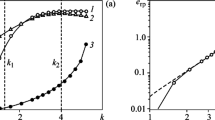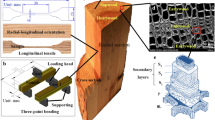Abstract
A fracture mechanics model for analysis of crack initiation and propagation in wood is defined and applied. The model has the advantage of being simple, yet it enables reasonably general and accurate analysis commonly associated with more complex models. The present applied calculations are made by means of the finite element method and relate to progressive cleavage fracture along grain. The calculations concern a tapered double cantilever beam specimen and an end-notched beam. Comparisons are made of experimental test results. The fracture properties of the wood are modelled by means of a very thin linear elastic layer located along the crack propagation path. The properties of the layer are such that the strength and fracture energy of the wood are represented correctly. This makes a single linear elastic calculation sufficient for strength prediction. Both crack development and pre-existing cracks can be analyzed. Both material strength and fracture energy and stiffness are taken into account, their relative influence on structural strength being different for different elements. The fracture layer is in the finite element context represented by joint elements. Propagation of a crack can be analyzed either by a series of elastic calculations corresponding to different crack lengths or by use of a finite element code for non-linear analysis. The computational results include sensitivity analysis with respect to the influence of the various material parameters on structural strength.













Similar content being viewed by others
References
Aicher S, Gustafsson PJ, Haller P, Petersson H (2002) Fracture mechanics models for strength analysis of timber beams with a hole or a notch—a report of RILEM TC-133. Report 7134, Div. of Structural Mechanics, Lund University, Sweden
Barenblatt GI (1962) The mathematical theory of equilibrium cracks in brittle fracture. Adv in appl mech, 7:55–129
Beer G (1985) An isoparametric joint/interface element for the analysis of fractured rock. Int J Numer Meth Eng 21:585–600
Boström L (1992) Method for determination of the softening behaviour of wood and the applicability of a nonlinear fracture mechanics model. PhD-thesis, Report TVBM-1012, Div. of Building Materials, Lund University, Sweden
Boyancé P (1999) Modélisation de la rupture différée d’un matériau orthotrope viscoélastique en environnement naturel: application à un composite à base de bois, le LVL. Thesis, Université Bordeaux I
Coureau JL (2002) Renforcement local d’éléments de structures bois par des matériaux composites. Thesis, Université Bordeaux I
Coureau JL, Cuvillier E (2003) Prédiction de la résistance d’éléments de structures en bois renforcés localement par des matériaux composites. Revue Française de Génie Civil, Vol 7, N° 4, pp 499–527, Edition Hermès
Courtinho ALGA, Martins MAD, Sydenstricker RM, Alves JLD, Landau L (2003) Simple zero thickness kinematically consistent interface elements. Comput Geotech 30:347–374
Dugdale DS (1960) Yielding in steel sheets containing slits. J Appl Mech Phys Sol 8:100–104
Foliente GC, McLain TE (1992) Strength of end-notched wood beams: a critical fillet hoop stress approach. Wood Fiber Sci 24(2):168–180
Gustafsson PJ (1985) Fracture mechanics studies of non-yielding materials like concrete. PhD-thesis, Report TVBM-1007, Div. of Building Materials, Lund University, Sweden
Gustafsson PJ (1987) Analysis of generalized Volkersen joints in terms of non-linear fracture mechanics. In: proceedings of European mechanics colloquium 227 Mechanical behavior of adhesive joints, St. Etienne, France, pp 323–338
Gustafsson PJ (1988) A study of strength of notched beams. CIB W18-A, Meeting 21, Paper 21–10–1
Gustafsson PJ (2003) Crack propagation in wood and wood products. In: Second international conference of the ESWM, Stockholm, pp 227–236
Hellan K (1984) Introduction to fracture mechanics. McGraw-Hill Book Company, New york
Hillerborg A, Modeer M, Petersson PE (1976) Analysis of crack formation and crack growth in concrete by the means of fracture mechanics and finite elements. Cement Concrete Res 6:773–782
Hunt DG, Rukhadze M (1991) Mixed-mode fracture of beams with nochted ends. In: International timber Engineering Conference , Vol 3, London, pp 367–374
Jensen JL, Gustafsson PJ (2004) Shear strength of splice joints with glued-in rods. J of Wood Sci, No 50, The Japan Wood Research Society, pp 123–129
Jensen JL, Gustafsson PJ, Larsen HJ (2003) A tensile fracture model for joints with rods or dowels loaded perpendicular-to-grain. In: Proceedings of CIB W18A meeting 26, USA
Larsen H (1992) Latest development of Eurocode 5. CIB W18-A, Meeting 25, Paper 21–10–2
Le Fichoux E (1998) Présentation et utilisation de CAST3M. ENSTA
Morel S (1998) Effet d’échelle dans la rupture d‘un matériau hétérogène (le bois)”. Thesis, Université Bordeaux I
Petersson H (1992) Analysis of fracture propagation. COST 508, Wood Mechanics, Worshop
Racois P (1994) Application de la mécanique de la rupture aux pouters entaillées fléchies (matériau bois). Thesis, Université Bordeaux I
Stefansson F (2001) Fracture analysis of orthotropic beams. Licentiate thesis, Report TVSM-3029, Div. of Structural Mechanics, Lund University, Sweden
Triboulot P, Jodin P, Pluvinage G (1984) Validity of fracture mechanics concepts applied to wood by finite element calculation. Wood Sci Technol 18:51–58
Valentin G, Boström L, Gustafsson PJ, Ranta-Manus A, Gowda S (1991) Application of fracture mechanics to timber structures RILEM state of the art report. Technical Research Centre of Finland, Research Notes, 1262, Espoo
Van Der Put TACM (1992) Explanation of the mixed mode interaction equation and energy principleof wood. In: COST 508, Wood Mechanics, Worshop
Wernersson H (1994) Fracture characterization of wood adhesive joints. PhD-thesis, Report TVSM-1006, Div. of Structural Mechanics, Lund University, Sweden
Zalph BL, McLain TE (1992) Strength of wood beams with filleted interior notches : a new model. Wood Fiber Sci 24(2):204–215
Author information
Authors and Affiliations
Corresponding author
Rights and permissions
About this article
Cite this article
Coureau, JL., Gustafsson, P.J. & Persson, K. Elastic layer model for application to crack propagation problems in timber engineering. Wood Sci Technol 40, 275–290 (2006). https://doi.org/10.1007/s00226-005-0033-x
Received:
Published:
Issue Date:
DOI: https://doi.org/10.1007/s00226-005-0033-x




